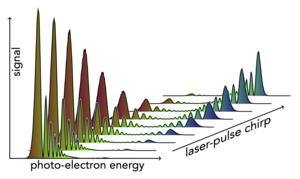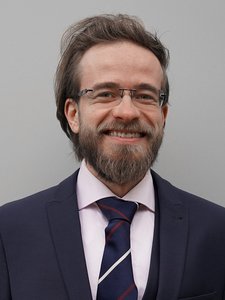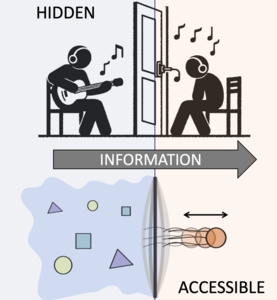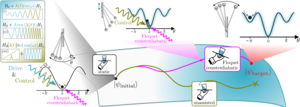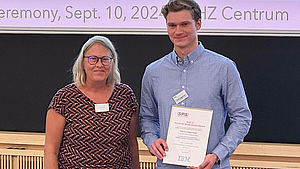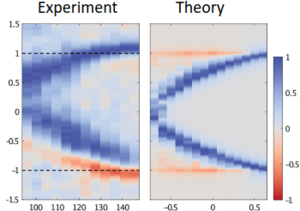
Highlights
Publication Highlights
Engineering Hierarchical Symmetries
Symmetry plays a crucial role in understanding fundamental phenomena such as conservation laws, the classification of phases of matter, and their transitions. Recently, researchers have been exploring ways to manipulate symmetries in quantum many-body systems with time-dependent driving protocols and, in particular, engineering new symmetries that do not occur naturally. This enriches the toolbox for quantum simulation and computation significantly, and has led to many exciting discoveries of nonequilibrium phases such as discrete time crystals. However, controlling multiple symmetries—especially in a simple and experimentally friendly way—has remained a challenge. Scientists from the Max Planck Institute for the Physics of Complex Systems have now proposed a novel method to engineer hierarchical symmetries by time-dependent protocols.
By controlling carefully how symmetry-indicating observables evolve over time, the researchers showed how to create a sequence of symmetries that emerge one after another, each with distinct properties. The method relies on a recursive construction that minimizes the effects of symmetry-breaking processes hierarchically. This leads to a corresponding sequence of prethermal steady states with controllable lifetimes, each exhibiting a lower symmetry than the preceding one. The scientists illustrate this protocol with several examples, demonstrating how different types of order can emerge through hierarchical symmetry breaking.
This toolbox of hierarchical symmetries opens a new path to stabilizing quantum states and controlling unwanted symmetry-breaking effects, which can be particularly useful in quantum computing and quantum simulation. The construction applies to classical and quantum, fermionic and bosonic, interacting and noninteracting systems. The underlying mechanism generalizes state-of-the-art dynamical decoupling techniques and is implementable on present-day quantum simulation platforms.
Zhanpeng Fu, Roderich Moessner, Hongzheng Zhao, and Marin Bukov, Phys. Rev. X 14, 041070 (2024)
Read moreBy controlling carefully how symmetry-indicating observables evolve over time, the researchers showed how to create a sequence of symmetries that emerge one after another, each with distinct properties. The method relies on a recursive construction that minimizes the effects of symmetry-breaking processes hierarchically. This leads to a corresponding sequence of prethermal steady states with controllable lifetimes, each exhibiting a lower symmetry than the preceding one. The scientists illustrate this protocol with several examples, demonstrating how different types of order can emerge through hierarchical symmetry breaking.
This toolbox of hierarchical symmetries opens a new path to stabilizing quantum states and controlling unwanted symmetry-breaking effects, which can be particularly useful in quantum computing and quantum simulation. The construction applies to classical and quantum, fermionic and bosonic, interacting and noninteracting systems. The underlying mechanism generalizes state-of-the-art dynamical decoupling techniques and is implementable on present-day quantum simulation platforms.
Zhanpeng Fu, Roderich Moessner, Hongzheng Zhao, and Marin Bukov, Phys. Rev. X 14, 041070 (2024)
Publication Highlights
Strong-field control in two-photon ionization
A few years ago, scientists from the Max Planck Institute for the Physics of Complex Systems
[Saalmann et al., Phys. Rev. Lett. 121, 153203 (2018)] predicted theoretically that the chirp of a short intense laser pulse offers the opportunity to control ionization of atoms with very high efficiency. By means of resonant two-photon processes one can switch between excitation and ionization with a contrast of nearly 100%. This mechanism has now been observed with chirped circularly-polarized laser pulses at the free-electron laser (FEL) FERMI in Trieste (Italy). FERMI belongs to the increasingly popular group of seeded FELs that allow accurate control of the characteristics of the short and intense laser pulses generated. In a large collaboration, led by researchers from the Albert-Ludwigs-Universität Freiburg (Germany), photo-electron spectra from Helium atoms for various chirps—that confirm the theoretical predictions—have been measured. These measurements are a crucial step towards coherent-control experiments making use of spectral-phase shaping in the XUV range of the electromagnetic spectrum.
Fabian Richter, Ulf Saalmann et al., Nature 636, 337 (2024)
Read more[Saalmann et al., Phys. Rev. Lett. 121, 153203 (2018)] predicted theoretically that the chirp of a short intense laser pulse offers the opportunity to control ionization of atoms with very high efficiency. By means of resonant two-photon processes one can switch between excitation and ionization with a contrast of nearly 100%. This mechanism has now been observed with chirped circularly-polarized laser pulses at the free-electron laser (FEL) FERMI in Trieste (Italy). FERMI belongs to the increasingly popular group of seeded FELs that allow accurate control of the characteristics of the short and intense laser pulses generated. In a large collaboration, led by researchers from the Albert-Ludwigs-Universität Freiburg (Germany), photo-electron spectra from Helium atoms for various chirps—that confirm the theoretical predictions—have been measured. These measurements are a crucial step towards coherent-control experiments making use of spectral-phase shaping in the XUV range of the electromagnetic spectrum.
Fabian Richter, Ulf Saalmann et al., Nature 636, 337 (2024)
Awards and Honors
Libor Šmejkal awarded the Walter Schottky Prize
Libor Šmejkal, group leader at the MPI-PKS jointly with MPI-CPfS, has been awarded the 2025 Walter Schottky Prize by the German Physical Society (DPG) "for his prediction of altermagnetism, a new class of magnetic order with diverse fundamental and application-oriented perspectives".
Libor Šmejkal was the first to demonstrate the phenomenon of altermagnetism. It is a new fundamental magnetic phase exhibiting a spin-polarized d/g/i-wave order in the non-relativistic band structure, thus differing significantly from conventional ferromagnetism and antiferromagnetism. Previously, the understanding of conventional ferromagnets and antiferromagnets was considered very complete, so Šmejkal's discovery came as an unexpected turn in the scientific community.
Libor Šmejkal was educated at Charles University in Prague under the supervision of Tomas Jungwirth and Jairo Sinova (Mainz), where he received his PhD in 2020. Subsequently, he headed an independent research group at Johannes Gutenberg University Mainz and, since 2024, has been the head of an independent research group at the Max Planck Institute for the Physics of Complex Systems in Dresden.
The Walter Schottky Prize is awarded by the German Physical Society (DPG) for outstanding work published within the last two years, preferably in the past year, in the field of solid-state physics by one or more young physicists. The prize consists of a €10,000 award and a certificate.
Read moreLibor Šmejkal was the first to demonstrate the phenomenon of altermagnetism. It is a new fundamental magnetic phase exhibiting a spin-polarized d/g/i-wave order in the non-relativistic band structure, thus differing significantly from conventional ferromagnetism and antiferromagnetism. Previously, the understanding of conventional ferromagnets and antiferromagnets was considered very complete, so Šmejkal's discovery came as an unexpected turn in the scientific community.
Libor Šmejkal was educated at Charles University in Prague under the supervision of Tomas Jungwirth and Jairo Sinova (Mainz), where he received his PhD in 2020. Subsequently, he headed an independent research group at Johannes Gutenberg University Mainz and, since 2024, has been the head of an independent research group at the Max Planck Institute for the Physics of Complex Systems in Dresden.
The Walter Schottky Prize is awarded by the German Physical Society (DPG) for outstanding work published within the last two years, preferably in the past year, in the field of solid-state physics by one or more young physicists. The prize consists of a €10,000 award and a certificate.
Publication Highlights
Listening to hidden signals: how biological systems optimise inaccessible information
Living organisms must sense and process information from their surroundings to survive, but they often cannot directly “listen” to external signals. For example, the internal processes of a red blood cell can only access the external world through the cellular membrane, but how well can this membrane transmit such information? And how can information transmission be achieved with a limited energy budget? Giorgio Nicoletti of EPFL Lausanne and Daniel Busiello of the Max Planck Institute for the Physics of Complex Systems have now shown that, by optimising energy and information at the same time, biological systems can tune themselves to harvest maximal information from the environment. These highly efficient strategies require a price in terms of energy consumption, but this price is far outweighed by the information learned about the hidden, external signals. A particularly relevant case study for these results is red blood cells: The authors quantify how much information about the state of the internal cytoskeleton is transmitted into the flickering of their membrane, unraveling a deep connection between healthy cellular conditions, energy dissipation, and information. In particular, the mechanical stress of the cell affects its efficiency in terms of how well information is transmitted, providing novel and fundamental insights into the functioning of biological systems in complex environments.
Giorgio Nicoletti and Daniel Maria Busiello, Phys. Rev. Lett. 133, 158401 (2024)
Selected for a Viewpoint in Physics.
Read moreGiorgio Nicoletti and Daniel Maria Busiello, Phys. Rev. Lett. 133, 158401 (2024)
Selected for a Viewpoint in Physics.
Publication Highlights
Counterdiabatic driving for periodically driven systems
Periodically driven systems have emerged as a useful technique to engineer the properties of quantum systems, and are in the process of being developed into a standard toolbox for quantum simulation. An outstanding challenge that leaves this toolbox incomplete is the manipulation of the states dressed by strong periodic drives. To achieve fast control of nonequilibrium quantum matter, Paul Schindler and Marin Bukov of the Max Planck Institute for the Physics of Complex Systems have now generalised the notion of variational counterdiabatic driving away from equilibrium. The researchers discuss applications to two-level, Floquet band, and interacting periodically driven models.
Paul M. Schindler and Marin Bukov, Phys. Rev. Lett. 133, 123402 (2024)
Read morePaul M. Schindler and Marin Bukov, Phys. Rev. Lett. 133, 123402 (2024)
Institute's News
The call for the 2025 Distinguished PKS Postdoctoral Fellowship is open!
The application deadline for this call is the 15 of November 2024. Distinguished PKS postdoctoral fellows appear personally along with the departments and groups on the main research page of the institute and are expected to have at least one year of postdoctoral experience at an institution other than the one at which their PhD was awarded. Applications for this fellowship directly after completion of the PhD might be considered in exceptional cases.
Please click on the button to see the full advertisement!
Read morePublication Highlights
Leader cells created with light cannot pull cell trains on their own
In biological processes such as embryonic development, wound healing, and cancer invasion, cells move in cohesive groups. These groups are often led by a so-called leader cell, which is thought to pull and direct the followers. New work by Ricard Alert of the Max Planck Institute for the Physics of Complex Systems and his experimental collaborators in the group of Xavier Trepat at the Institute for Bioengineering of Catalonia (IBEC) now shows that the local action of a leader is not enough to guide the migration of cell groups. Instead, the researchers show that mechanical coordination across the entire cell group is needed for the group to move.
To test whether leader cells can pull others, the scientists used genetically-modified cells that turn into leaders when illuminated with blue light. In this way, the team could create leader cells on demand. The researchers then studied whether leader cells could act as the locomotive of small cell trains, up to four cells long. They found that a leader cell can robustly drag one follower but not longer cell trains. Leader cells therefore need the contribution of followers to guide the group. Ricard Alert then developed a physical model that shows how the motion of cell trains arises from asymmetries in cellular traction forces across the entire cell train, in agreement with the team’s experimental measurements. The new work therefore challenges the notion of autonomous leader cells, and it shows that cells need to coordinate their forces to move in groups.
More details can be found in the press release (PDF).
Leone Rossetti, Steffen Grosser, Juan Francisco Abenza, Léo Valon, Pere Roca-Cusachs, Ricard Alert, and Xavier Trepat. Optogenetic generation of leader cells reveals a force–velocity relation for collective cell migration, Nat. Phys. (2024)
Read moreMore details can be found in the press release (PDF).
Leone Rossetti, Steffen Grosser, Juan Francisco Abenza, Léo Valon, Pere Roca-Cusachs, Ricard Alert, and Xavier Trepat. Optogenetic generation of leader cells reveals a force–velocity relation for collective cell migration, Nat. Phys. (2024)
Awards and Honors
Patrick Lenggenhager receives SPS thesis award
Every year, the Swiss Physical Society (SPS) awards a few young physicists for outstanding research work during their doctoral studies. This year, Patrick Lenggenhager, who joined MPI-PKS last year as a postdoc, is the recipient of the SPS award for condensed matter physics. In his doctoral thesis, Patrick explored multigap topology and hyperbolic lattices, two emerging avenues in band theory that are tied together by the overarching concepts of symmetry and topology. His findings advance the state of the art in these two key frontiers and underscore the centrality of band theory as a tool to uncover novel physical phenomena. We would like to congratulate Patrick on this impressive achievement and celebrate his contributions to condensed matter physics, which are sure to grow even larger in the coming years!
Read morePublication Highlights
Lifting the Veil of Topological Censorship
Topological protection provides unprecedented robustness of physical phenomena against all kinds of perturbations; but in doing so, it exercises topological censorship by hiding all kinds of interesting and important microscopic information. Recent experiments have collected microscopic information precisely of the kind hidden by such Topological Censorship. The work by Douçot, Kovrizhin and Moessner provides a detailed microscopic theory which goes beyond such topological censorship. It not only identifies an unexpected phenomenon – the meandering edge state carrying topologically quantised current – at variance with common expectations; but also identifies mechanisms which allow for tuning between qualitatively different microscopic implementations corresponding to one and the same topologically protected global quantity.
More details can be found in the press release (PDF).
Benoit Douçot, Dmitry Kovrizhin, and Roderich Moessner, Proc. Natl. Acad. Sci. USA, 121, e2410703121 (2024)
Read moreMore details can be found in the press release (PDF).
Benoit Douçot, Dmitry Kovrizhin, and Roderich Moessner, Proc. Natl. Acad. Sci. USA, 121, e2410703121 (2024)
Awards and Honors
Libor Šmejkal receives ERC starting grant
The European Research Council (ERC) has announced prestigious starting grants to researchers to set up their own teams and conduct research on the topics of their choice. One of these researchers is Libor Smejkal, a new group leader at MPI-PKS & MPI-CPfS, with his successful proposal on "Magnetic counterparts of unconventional superconductors for spin-conserved and non-dissipative electronics". The project will explore topological and quantum variants of unconventional magnets that are analogues to unconventional superfluids and superconductors. Libor's group will also search for realistic material candidates enabling low-dissipation electronics based on the unconventional magnetism. Congratulations!!
Read more

